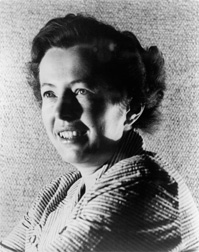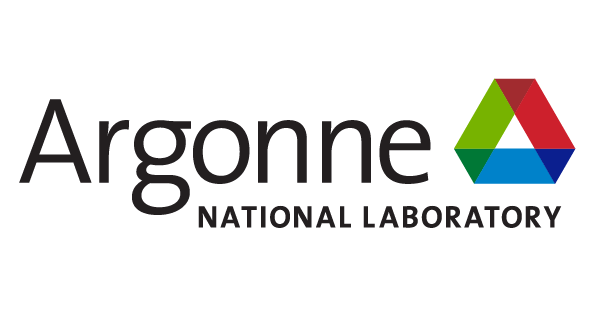Celebrating 75 Years of the Nuclear Shell Model and Maria Goeppert-Mayer
Physics Division Auditorium
Argonne National Laboratory
 This year marks the 75th anniversary of the nuclear shell model, for which Maria Goeppert-Mayer and Hans Jensen won the Nobel Prize in Physics in 1963. In commemoration of this historic anniversary, Argonne National Laboratory and the University of Chicago hosted a symposium from July 19 to 21, 2024, dedicated to celebrating the legacy and enduring impact of the nuclear shell model and Maria Goeppert-Mayer's contributions to science. The symposium brought together researchers at all stages of their careers whose research descends from the development of the shell model. Topics presented ranged from historical overviews of 75 years of progress to ongoing research at the forefront of nuclear physics.
This year marks the 75th anniversary of the nuclear shell model, for which Maria Goeppert-Mayer and Hans Jensen won the Nobel Prize in Physics in 1963. In commemoration of this historic anniversary, Argonne National Laboratory and the University of Chicago hosted a symposium from July 19 to 21, 2024, dedicated to celebrating the legacy and enduring impact of the nuclear shell model and Maria Goeppert-Mayer's contributions to science. The symposium brought together researchers at all stages of their careers whose research descends from the development of the shell model. Topics presented ranged from historical overviews of 75 years of progress to ongoing research at the forefront of nuclear physics.
To commemorate the impact Maria Goeppert-Mayer has had on generations of women physicists, a session was dedicated to celebrating women and other underrepresented populations in physics. In an effort to continue her great legacy, discussions highlighted the accomplishments of women in physics as well as provided opportunities for dialogue about current challenges still faced by women and underrepresented minorities in physics and how we, as a community, can pursue a more equitable and diverse field.
This event was supported by:
Image of Maria Goeppert-Mayer from the University of Chicago Photographic Archive, [apf1-10468], Hanna Holborn Gray Special Collections Research Center, University of Chicago Library.
-
-
Introductory Session Auditorium (Advanced Photon Source)
Auditorium
Advanced Photon Source
Convener: Anna McCoy-
1
WelcomeSpeaker: Kawtar Hafidi (Argonne National Laboratory)
-
2
A brief history of a big idea for a small thingSpeaker: Calvin Johnson (San Diego State University)
-
3
Development and Applications of the ab initio No-Core Shell ModelSpeaker: James Vary (Iowa State University)
-
1
-
10:40 AM
Coffee break Advanced Photon Source
Advanced Photon Source
-
Colloquium Auditorium (Advanced Photon Source)
Auditorium
Advanced Photon Source
Convener: Anna McCoy-
4
Maria Goeppert Mayer – From Göttingen to the Nobel Prize in Physics
The talk will present an overview of Maria Goeppert-Mayer’s life and her accomplishments in physics. Being trained in quantum theory at the famous Göttingen school of Max Born, she became friends with many of the most influential physicists of the early 20th century. Albeit, as a woman and the wife of Joseph Mayer, she was considered unemployable in the United States, after her emigration from Germany. Nevertheless, she continued working as unpaid lecturer and made several substantial contributions to atomic and molecular physics. Collaborating with Edward Teller during World War II, she shifted her focus to nuclear physics, particularly to the field of nuclear astrophysics. Her research on the correlation between stellar abundances and the numbers of protons or neutrons in a nucleus, led her to the identification of magic numbers. Despite being dismissed by many physicists, her exploration into "numerology" ultimately led to the recognition of the shell structure of the nucleus. In 1963, she was honored with the Nobel Prize for her groundbreaking discovery.
Speaker: Michael Wiescher (University of Notre Dame)
-
4
-
12:00 PM
Lunch Advanced Photon Source
Advanced Photon Source
-
Invited Talks Auditorium (Advanced Photon Source)
Auditorium
Advanced Photon Source
Convener: Donald Geesaman-
5
Quest for a comprehensive shell model to track the evolution in nuclear structureSpeaker: Rebeka Lubna (FRIB)
-
6
Overview of the History of the Nuclear Shell Model and Personal Perspectives on its FutureSpeaker: Jerry Draayer (LSU)
-
7
Microscopic effective interactions for the nuclear shell modelSpeaker: Nadya Smirnova (GANIL)
- 8
-
5
-
2:40 PM
Coffee break Advanced Photon Source
Advanced Photon Source
-
Invited Talks Auditorium (Advanced Photon Source)
Auditorium
Advanced Photon Source
Convener: Robert Wiringa-
9
Towards a microscopic understanding of the shell model: status and open questionsSpeaker: Ragnar Stroberg (ND)
- 10
-
11
Large-scale shell-model calculations, quasi-particle shell model, and their applicationsSpeaker: Noritaka Shimizu (University of Tsukuba)
-
9
-
4:15 PM
Coffee break Advanced Photon Source
Advanced Photon Source
-
Invited Talks Auditorium (Advanced Photon Source)
Auditorium
Advanced Photon Source
Convener: Patrick Fasano (Argonne National Laboratory)-
12
Structure and reaction observables of drip-line nuclei with the Gamow Shell ModelSpeaker: Nicolas Michel (Institute of Modern Physics, Lanzhou)
- 13
-
14
Pushing the limits of the shell model towards the continuumSpeaker: Kostas Kravvaris (LLNL)
-
12
-
-
-
Invited Talks Auditorium (Building 203)
Auditorium
Building 203
Convener: Takaharu Otsuka-
15
Celebrating Maria Goeppert twice: shell model and double beta decaySpeaker: Javier Menendez (University of Barcelona)
-
16
The shell structure of the neutron-rich Ca isotopesSpeaker: Pieter Doornenbal (RIKEN)
-
17
Deconstructing the $g_A$ puzzle within the realistic shell modelSpeaker: Luigi Coraggio (Università degli Studi "Luigi Vanvitelli" - INFN Naples)
-
18
Ab initio studies on muon capture to probe neutrinoless double-beta decaySpeaker: Lotta Jokiniemi (TRIUMF)
-
15
-
10:40 AM
Coffee break Physics Division Auditorium
Physics Division Auditorium
Argonne National Laboratory
9700 S Cass Ave Lemont, IL 60439 -
Invited Talks Auditorium (Building 203)
Auditorium
Building 203
Convener: Matthew Mumpower (Los Alamos National Laboratory)-
19
Shell model meets in-beam gamma-ray spectroscopy on both sides of the nuclear chartSpeaker: Alexandra Gade (Facility for Rare Isotope Beams, Michigan State University)
-
20
Nuclear Data in the Cosmos from the Interacting Shell ModelSpeaker: Sofia Karampagia (Grand Valley State University)
-
21
Frontiers in explosive nuclear astrophysicsSpeaker: Gavin Lotay (University of Surrey)
-
19
-
12:15 PM
Lunch Physics Division Auditorium
Physics Division Auditorium
Argonne National Laboratory
9700 S Cass Ave Lemont, IL 60439 -
1:00 PM
Travel to Chicago
-
2:00 PM
Coffee break University of Chicago
University of Chicago
-
Celebrating Women in Physics: CWP Maria Goeppert-Mayer Lecture Hall (University of Chicago)
Maria Goeppert-Mayer Lecture Hall
University of Chicago
Conveners: Chiara Bissolotti (Argonne National Laboratory), Young-Kee Kim (University of Chicago)-
22
WelcomeSpeakers: Chiara Bissolotti (Argonne National Laboratory), Young-Kee Kim (University of Chicago)
-
23
No-Core Shell Model densities and ab initio effective potentials for elastic nucleon-nucleus scatteringSpeaker: Charlotte Elster (Ohio University)
-
24
No Nus is Good News: From the Origin of Matter, to the Rarest Radioactive Decay in the UniverseSpeaker: Leslie Rogers (Argonne National Laboratory)
-
25
Journey into Biological MaterialsSpeaker: Alison Patteson (Syracuse University)
-
26
Nuclear Issues in National SecuritySpeaker: Rhiannon Hutton (Institute for Defense Analyses)
-
22
-
4:15 PM
Coffee break Physics Division Auditorium
Physics Division Auditorium
Argonne National Laboratory
9700 S Cass Ave Lemont, IL 60439 -
Celebrating Women in Physics: Panel discussion Maria Goeppert-Mayer Lecture Hall (University of Chicago)
Maria Goeppert-Mayer Lecture Hall
University of Chicago
Convener: Young-Kee Kim (University of Chicago) -
Celebrating Women in Physics: Small group discussions Maria Goeppert-Mayer Lecture Hall (University of Chicago)
Maria Goeppert-Mayer Lecture Hall
University of Chicago
-
Poster Session University of Chicago
University of Chicago
-
7:00 PM
Conference Dinner City View Room (David Rubenstein Forum)
City View Room
David Rubenstein Forum
1201 E 60th St, Chicago, IL 60637
-
-
-
Invited Talks Auditorium (Building 203)
Auditorium
Building 203
Convener: Christopher Fasano (Monmouth College)-
27
Spin-Orbit Splittings in the Presence of Weak BindingSpeaker: Benjamin Kay (Argonne National Laboratory)
-
28
Isospin Symmetric Island of Inversion at the N=Z lineSpeaker: Frederic Nowacki (Institut Pluridisciplinaire Hubert Curien, Strasbourg)
-
29
Some aspects of the quenching of single-particle strengthSpeaker: Augusto Macchiavelli (Oak Ridge National Laboratory)
-
27
-
10:45 AM
Coffee break Physics Division Auditorium
Physics Division Auditorium
Argonne National Laboratory
9700 S Cass Ave Lemont, IL 60439 -
Invited Talks Auditorium (Building 203)
Auditorium
Building 203
Convener: Garrett King-
30
Ab Initio Investigation of Radiative Capture and Electron-Positron Pair ProductionSpeaker: Peter Gysbers (Facility for Rare Isotope Beams, Michigan State University)
-
31
Beta decay recoil-order terms for studies of physics beyond the Standard ModelSpeaker: Grigor Sargsyan (Facility for Rare Isotope Beams, Michigan State University)
-
32
Ab initio theory towards reliable neutrinoless double beta decay nuclear matrix elementSpeaker: Antoine Belley (TRIUMF)
-
30
-
12:15 PM
Lunch Physics Division Auditorium
Physics Division Auditorium
Argonne National Laboratory
9700 S Cass Ave Lemont, IL 60439 -
Invited Talks Auditorium (Building 203)
Auditorium
Building 203
Convener: Mark Caprio (University of Notre Dame)-
33
Quantum Computing and the Shell ModelSpeaker: Jon Engel (University of North Carolina)
-
34
Neural network quantum states for the nuclear many-body problemSpeaker: Alessandro Lovato (Argonne National Laboratory)
-
35
A weak entanglement approximation for nuclear structure: proton-neutron approximate shell modelSpeaker: Oliver Gorton (Lawrence Livermore National Laboratory)
-
33
-
2:30 PM
Coffee break Physics Division Auditorium
Physics Division Auditorium
Argonne National Laboratory
9700 S Cass Ave Lemont, IL 60439 -
Invited Talks Auditorium (Building 203)
Auditorium
Building 203
Convener: Nirupama Sensharma-
36
Elucidating the Ge nuclei with the shell modelSpeaker: Erin Peters (University of Kentucky)
-
37
Level Densities and Gamma-Ray Strength Functions in Heavy Nuclei with Shell-Model Monte CarloSpeaker: Dallas DeMartini (Yale University)
-
38
Nuclear shapes studied by Monte Carlo shell model calculationsSpeaker: Yusuke Tsunoda (Center for Nuclear Study, University of Tokyo)
-
36
-





